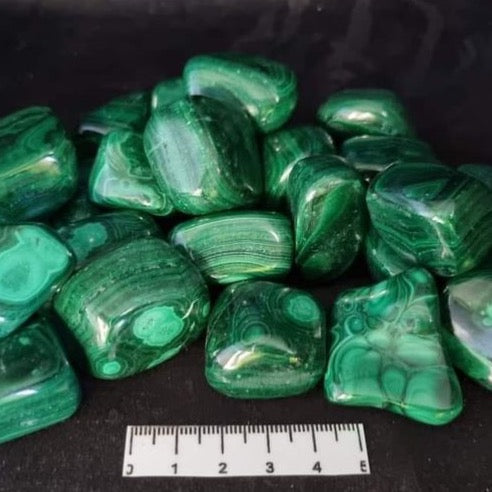
Malachite: A Green Legacy in Mineral Form
Share
View and Shop Our Malachite Collection
Malachite is a visually striking copper-based mineral, prized for its rich green colour and rhythmic banding. Known chemically as copper carbonate hydroxide (Cu₂CO₃(OH)₂), it has been admired across cultures for thousands of years—used in jewellery, carvings, pigments, and architecture. Its aesthetic appeal, combined with its geological significance, makes it a mineral of enduring interest to collectors, scientists, and artisans.
The name “malachite” derives from the Greek word malache, meaning “mallow,” referencing the green leaves of the mallow plant—a fitting nod to its natural hue.
Geological Formation and Physical Properties
Malachite forms as a secondary mineral in the oxidised zones of copper ore bodies. It develops when oxygen-rich, carbonated groundwater reacts with primary copper sulphides such as chalcopyrite, bornite, and chalcocite. As these sulphides break down, copper ions are released into solution. In the presence of carbonate and hydroxide ions, malachite precipitates under low-temperature, near-surface conditions, typically within porous or fractured host rocks such as limestone, sandstone, or altered volcanic formations.
This mineral commonly occurs alongside azurite, chrysocolla, and cuprite, depending on local pH, redox state, and fluid chemistry. Its morphology varies widely, forming botryoidal masses, stalactitic growths, and fibrous crusts. The banded appearance results from episodic changes in fluid composition and flow rate, producing rhythmic layers of fibrous crystals. These differ from agate’s concentric silica bands, reflecting malachite’s unique copper-rich origin.
Malachite crystallises in the monoclinic system and typically displays a vitreous to silky lustre. It has a pale green streak, a refractive index ranging from 1.655 to 1.909, and a specific gravity between 3.6 and 4.0. With a hardness of 3.5 to 4 on the Mohs scale, it is relatively soft and requires careful handling.
Its occurrence in the supergene zone makes it a reliable indicator of near-surface copper enrichment and a valuable guide in mineral exploration.
Cultural and Scientific Significance
Malachite has long held symbolic and decorative value. In ancient civilisations, it was carved into amulets, beads, and ceremonial objects, often believed to offer protection from harm. Polished specimens reveal intricate banding that has adorned everything from Egyptian tombs to Russian palaces.
In modern gemology, malachite is classified as a minor gemstone. It is commonly shaped into cabochons, beads, and inlay work. Its presence in rock formations continues to serve as a visual cue for copper mineralisation, aiding geologists in identifying potential ore zones.
Historically, malachite was also ground into pigment for use in paints and dyes. Though its sensitivity to acids and light limits its stability, it was widely employed in tempera and fresco techniques across cultures—from Renaissance art to Byzantine mosaics.
Care and Handling
Due to its softness and chemical sensitivity, malachite requires gentle care. It should be kept away from acids, ammonia, and heat, and never cleaned with ultrasonic devices or harsh solvents. A soft cloth and mild soap are recommended for cleaning, and specimens should be stored in a dry, padded container to prevent scratching or abrasion.
Some commercial pieces may be stabilised or coated to improve durability, particularly in jewellery applications.
Conclusion
Malachite’s layered structure and vibrant green tones reflect both its geological origins and its cultural legacy. Whether appreciated for its mineralogical complexity or its aesthetic value, it remains a compelling example of nature’s ability to transform elemental chemistry into enduring beauty.
Crystal World Wholesale Group proudly supplies a range of high-quality malachite specimens—If you're a retailer or business looking to source malachite, we invite you to sign up for a wholesale account today and gain access to exclusive pricing and inventory.
View and Shop Our Malachite Collection
References
- Klein, C., & Dutrow, B. – Manual of Mineral Science (23rd Edition), Wiley
- Mindat.org – https://www.mindat.org/min-2556.html
- Webmineral.com – http://webmineral.com/data/Malachite.shtml
- Geology.com – https://geology.com/minerals/malachite.shtml